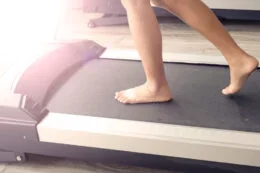Can You Run Barefoot On A Treadmill?

The sensation of barefoot running has gripped many enthusiasts who swear by its natural feel and foot strengthening benefits. However, the question arises: is it acceptable to transfer this practice to the treadmill? Running without the cushioning and support of shoes on a treadmill is a subject of debate, with considerations regarding safety, hygiene, and performance to take into account. Yes, you can run barefoot on a treadmill but there are special considerations noted below.
Drawbacks of Running Barefoot on a Treadmill
The controlled environment of a treadmill offers the allure of convenience for running. However, this controlled setting might not translate well when running without the protective layer of shoes.
Running without shoes on a treadmill strips away the critical cushioning and support that running shoes are designed to provide. This change not only alters your running form but also predisposes your feet to a spectrum of injuries.
Increased Risk of Injury When Running Barefoot
Starting barefoot running on a treadmill without the safeguarding features of shoes exposes your feet to potential injuries.
- Surface dangers: The moving belt increases the risks of cuts and injuries from exposure to the treadmill’s textured belt.
- Strain on the lower extremities: The absence of cushioning can strain the feet, escalating the risk of stress fractures or tendonitis.
- Plantar fasciitis: Lacking proper arch support invites the chance of developing this painful condition.
- Thermal injury: Treadmill heat can burn the soles of unprotected feet.
- Blisters and abrasions: Consistent friction against the treadmill belt can cause these painful issues without the protective barrier of shoes.
Hygiene Issues when running barefoot on a treadmill
Hygiene becomes a critical concern when shoes are shunned on a treadmill, impacting both personal and public health considerations.
- Fungal infections: Treadmills foster a moist, warm environment ripe for infectious organisms to thrive.
- Unseen debris: Encountering debris or rough patches on the belt can lead to cuts and scrapes.
- Contagion risk: Shared gym equipment increases the spread of skin infections among barefoot users.
- Personal hygiene: Accumulation of sweat and skin cells necessitates a more rigorous cleaning routine.
- Mechanical harm: Treadmill components pose a risk when encountered with bare feet.
Reduced shock absorption when running barefoot on treadmill
Without running shoes, shock absorption is drastically lessened, shifting more stress onto your body.
- Inefficient impact dissipation: Your feet’s soles alone are not as efficient as cushioned shoes at reducing shock.
- Repetitive stress: The uniform treadmill belt surface can focus stress on repeated foot and leg areas.
- Heat vulnerability: The belt’s friction-generated heat becomes a direct threat to bare feet.
- Overuse injuries: Lack of shoes can lead to common injuries such as plantar fasciitis or stress fractures.
- Biomechanical changes: Over time, running barefoot may alter the way you run, potentially leading to altered gait patterns.
Running barefoot appeals as a form of embracing our ancestral roots and possibly improving foot mechanics and strength. Nonetheless, doing so on a treadmill presents unique challenges that merit serious consideration. Predominantly, the lack of cushioning and support can engender injuries, while hygiene issues pose additional risks. Finally, the treadmill environment lacks natural variations found outdoors, which our feet might expect for proper shock absorption. Before choosing to run barefoot on a treadmill, weigh the potential risks against the benefits. If you decide to proceed, approach this practice with caution, and gradually build up to ensure the safety and health of your feet.
Related Articles
Other Treadmill Reviews:
- Test HomePage
- NordicTrack Commercial X14i
- Echelon Stride
- NordicTrack C 590 Pro
- NordicTrack T 7.5 S - Pros & Cons (2024)
- Sole TD80 Treadmill Desk
- NordicTrack Commercial X11i
- NordicTrack T 8.5 S - Pros & Cons (2024)
- Horizon Elite T5
- Exerpeutic TF1000
- NordicTrack T 6.5 S - Pros & Cons (2024)
- ProForm Sport 5.0
- ProForm Premier 900
- ProForm ZT6
- NordicTrack FreeStride Trainer FS5i (Discontinued)
- Bowflex Max Trainer M5
- BowFlex TreadClimber TC100
- ProForm Power 795
- ProForm Sport 7.0
- NordicTrack Incline Trainer X15i
- NordicTrack C 1650 Treadmill
- Horizon Elite T9
- Official Boston Marathon Treadmill 4.0
- NordicTrack Treadmill Desk
- NordicTrack C 1630 Pro
- NordicTrack C 970 PRO
- Bowflex TC20 TreadClimber

